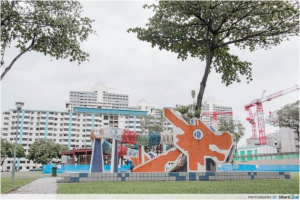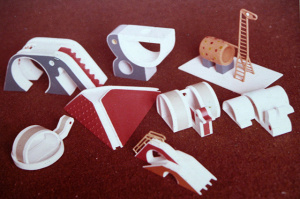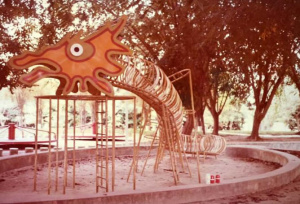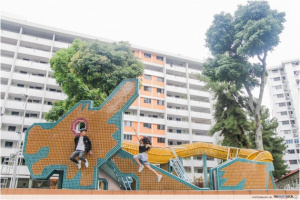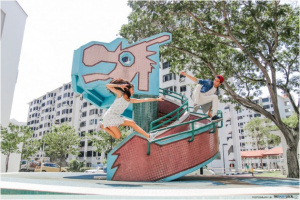Dragon Playground (Toa Payoh Lorong 6): Difference between revisions
Dayana Rizal (talk | contribs) |
Dayana Rizal (talk | contribs) m (Dayana Rizal moved page Dragon Playground to Dragon Playground (Toa Payoh Lorong 6)) |
||
| (9 intermediate revisions by 2 users not shown) | |||
| Line 1: | Line 1: | ||
[[File:Dragon Playground Toa Payoh.jpg|thumb|''The Orange Dragon Playground located at Toa Payoh Lorong 6.'' ''Photo from The Smart Local.'']] | [[File:Dragon Playground Toa Payoh.jpg|thumb|''The Orange Dragon Playground located at Toa Payoh Lorong 6.'' ''Photo from The Smart Local.'']] | ||
[[File:Dove playground at the heart of Dakota Crescent.jpg|thumb|''The Dove Playground that was built at Dakota. The playground was also designed by Khor Ean Ghee.'']] | [[File:Dove playground at the heart of Dakota Crescent.jpg|thumb|''The Dove Playground that was built at Dakota. The playground was also designed by Khor Ean Ghee.'']] | ||
The Dragon Playground has become a unique icon of Singapore, appearing on localised merchandise such as tote bags and pins. The Orange Dragon Playground was officially opened to the public in 1979, alongside other animal inspired playgrounds such as the Dove Playground in Dakota.<ref>Zhuang, Justin. "Space For A Nation to Play". ''Ministry of Culture, Community and Youth.'' November 25, 2015. Accessed on 27 March 2019. Retrieved from: https://www.sg/en/SG50/Pulse/Space%20For%20A%20Nation%20to%20Play.aspx</ref> As of 2019, there remains 4 Dragon Playgrounds in Singapore, with the largest located in Toa Payoh Lorong 6, a mature housing estate in Singapore. | The Dragon Playground has become a unique icon of Singapore, appearing on localised merchandise such as tote bags and pins. The Orange Dragon Playground was officially opened to the public in 1979, alongside other animal inspired playgrounds such as the Dove Playground in Dakota.<ref>Zhuang, Justin. "Space For A Nation to Play". ''Ministry of Culture, Community and Youth.'' November 25, 2015. Accessed on 27 March 2019. Retrieved from: https://www.sg/en/SG50/Pulse/Space%20For%20A%20Nation%20to%20Play.aspx</ref> As of 2019, there remains 4 Dragon Playgrounds in Singapore, with the largest located in Toa Payoh Lorong 6, a mature housing estate in Singapore. | ||
| Line 9: | Line 10: | ||
By the 1970s, most Singaporeans were housed in high-rise pubic housing estates that had been built by the HDB. The playgrounds were conceptualised in order to instil a sense of national identity among younger generation Singaporeans.<ref>Zhuang, Justin. ''Mosaic Memories: Remembering the playgrounds Singapore grew up in'' (Singapore: In Plain Words, 2012), p.7. Retrieved from: https://www.singaporememory.sg/data/res27/mosaic_memories.pdf</ref> As the availability of HDB flats increased in the late’ 70s, public housing moved beyond its utilitarian purposes. Playground were used to highlight the rising quality of living within those estates. | By the 1970s, most Singaporeans were housed in high-rise pubic housing estates that had been built by the HDB. The playgrounds were conceptualised in order to instil a sense of national identity among younger generation Singaporeans.<ref>Zhuang, Justin. ''Mosaic Memories: Remembering the playgrounds Singapore grew up in'' (Singapore: In Plain Words, 2012), p.7. Retrieved from: https://www.singaporememory.sg/data/res27/mosaic_memories.pdf</ref> As the availability of HDB flats increased in the late’ 70s, public housing moved beyond its utilitarian purposes. Playground were used to highlight the rising quality of living within those estates. | ||
<br /> | |||
==Background== | ==Background== | ||
[[File:Mini animal playground models.jpg|left|thumb|''Mr. Khor designed playgrounds inspired by various animals. The above are miniature models of Mr. Khor's designs. Photo from MCCY (SG).'']] | [[File:Mini animal playground models.jpg|left|thumb|''Mr. Khor designed playgrounds inspired by various animals. The above are miniature models of Mr. Khor's designs. Photo from MCCY (SG).'']] | ||
| Line 31: | Line 33: | ||
The attractive and low-maintenance nature of the Dragon made it a popular playground design choice in the 1980s among HDB developers. However the original design, which was housed in a 10 by 10 metre sand pit, was too big to fit into small housing estates.<ref>Zhuang, Justin. ''Mosaic Memories: Remembering the playgrounds Singapore grew up in'' (Singapore: In Plain Words, 2012), p.11. Retrieved from: https://www.singaporememory.sg/data/res27/mosaic_memories.pdf</ref> The design was then modified into “Baby Dragons”, which were significantly smaller in size due to the absence of the metal spine. | The attractive and low-maintenance nature of the Dragon made it a popular playground design choice in the 1980s among HDB developers. However the original design, which was housed in a 10 by 10 metre sand pit, was too big to fit into small housing estates.<ref>Zhuang, Justin. ''Mosaic Memories: Remembering the playgrounds Singapore grew up in'' (Singapore: In Plain Words, 2012), p.11. Retrieved from: https://www.singaporememory.sg/data/res27/mosaic_memories.pdf</ref> The design was then modified into “Baby Dragons”, which were significantly smaller in size due to the absence of the metal spine. | ||
<br /> | |||
==Existing dragon playgrounds== | ==Existing dragon playgrounds== | ||
[[File:Dragon Playground (Ang Mo Kio).jpg|thumb|''The Brown Dragon Playground at Ang Mo Kio Avenue 3.'' ''Photo from The Smart Local.'' ]] | [[File:Dragon Playground (Ang Mo Kio).jpg|thumb|''The Brown Dragon Playground at Ang Mo Kio Avenue 3.'' ''Photo from The Smart Local.'' ]] | ||
| Line 62: | Line 65: | ||
==References / Citations== | ==References / Citations== | ||
<references /> | <references /> | ||
[[Category:Singapore Places]] | |||
Latest revision as of 11:15, 25 November 2019
The Dragon Playground has become a unique icon of Singapore, appearing on localised merchandise such as tote bags and pins. The Orange Dragon Playground was officially opened to the public in 1979, alongside other animal inspired playgrounds such as the Dove Playground in Dakota.[1] As of 2019, there remains 4 Dragon Playgrounds in Singapore, with the largest located in Toa Payoh Lorong 6, a mature housing estate in Singapore.
Historical context
In 1973, the Housing & Development Board (HDB) developed a plan to build designated play areas in the new public housing estates.[2] HDB was established in 1960 in order to tackle the housing problem that Singapore faced at the time.[3]
By the 1970s, most Singaporeans were housed in high-rise pubic housing estates that had been built by the HDB. The playgrounds were conceptualised in order to instil a sense of national identity among younger generation Singaporeans.[4] As the availability of HDB flats increased in the late’ 70s, public housing moved beyond its utilitarian purposes. Playground were used to highlight the rising quality of living within those estates.
Background
Khor Ean Ghee
The then head of HDB, Liu Thai Ker, assigned one of HDB's in-house interior designers, Khor Ean Ghee, to design these playgrounds.[5] Khor Ean Ghee was raised in Penang, Malaysia and showed interest in drawing and water-colour painting since he was in primary school. He continued to pursue the Fine Arts in Taiwan Normal University. After graduating from university, he went to Singapore and successfully applied for an interior designer position at HDB.[6]
Khor Ean Ghee joined the Housing Development Board in 1969.[7] Mr. Khor's first playground designs were inspired by other animals such as giraffes and pelicans.
Design
The dragon is known as a fierce mythical creature in Asian culture as it symbolises power and strength.[8] The iconic design of the Dragon Playground went through 3 rounds of changes following various feedback from the public and estate developers.
The first version of the Dragon Playground was built at Toa Payoh Town Garden in 1975.[9] The fist version had a longer spine, a smaller head and a circular monkey bar instead of a slide. However, estate managers found the design unsatisfactory as they felt that the spine of the dragon was too long. It would also be too difficult to fabricate the metal head for other subsequent playgrounds.[10] The colour of the metal head would fade over time as well. This site was eventually demolished to make way for a temporary bus stop.
After taking into account the flaws of the previous version, Mr. Khor replaced the metal head with one created out of terrazzo and red, blue, orange and green glass tiles.[11] Mr. Khor designed the iconic second version of the Dragon Playground in 1977. It was introduced to the public in 1979. Besides giving the Dragon its unique mosaic look, the glass tiles significantly reduced the maintenance cost as there would be no need to repaint the site.
The attractive and low-maintenance nature of the Dragon made it a popular playground design choice in the 1980s among HDB developers. However the original design, which was housed in a 10 by 10 metre sand pit, was too big to fit into small housing estates.[12] The design was then modified into “Baby Dragons”, which were significantly smaller in size due to the absence of the metal spine.
Existing dragon playgrounds
In the 1980s many other Dragon Playgrounds were built around Singapore, scattered in housing estates from Bedok to Jurong East. Unfortunately, many of these playgrounds had been demolished. At Tampines, the Green Dragon that had been built in 1982 made way for a newer playground.[13] Two Blue Dragons located in Bedok and Hougang no longer exist. Two other dragons in Yishun and Jurong West were also demolished.
HDB ceased to develop its own playgrounds in 1993. Instead, pre-made plastic playground facilities were imported from overseas suppliers.[14] The glass tiles and sand pits were deemed dangerous for children, therefore HDB replaced most of the old playgrounds to meet the new international safety standards.[15] There are only 4 remaining Dragon Playgrounds in Singapore.
Toa Payoh Lorong 6 - Orange Dragon
Clad in orange mosaic tiles, this 40 year-old Dragon is the most well-known playground of its kind.[16] It is also the only Dragon Playground that still stands in a sand pit. This playground is located at 28 Lorong 6 Toa Payoh, with the nearest MRT station being Toa Payoh (NS19).
Ang Mo Kio Avenue 3 - Brown Dragon
This Dragon Playground designed by Mr Khor was completed in 1978.[17] The flooring had been replaced by soft padding. This playground is located at 570 Ang Mo Kio Ave 3, and the nearest MRT station is Ang Mo Kio (NS16).[18]
Pipit Road - Baby Red Dragon
The Dragon Playground located at Pipit Road is an example of the Baby Dragon Playgrounds that were built in estates with limited land area. Located at 53 Pipit Road in Macpherson, this playground features a spiraling staircase with a slide which leads back to the padded ground. The nearest MRT stations are Mattar (DT25) and MacPherson (CC10/DT26).
Toa Payoh Lorong 1 - Baby Orange Dragon
This playground was estimated to have been completed in 1985. Similar to its counterpart at Pipit Road, this Baby Dragon was also renovated in accordance with international safety standards. This site is located at 240 Toa Payoh Lorong 1, with the nearest MRT being Braddell (NS18).[19]
Public reception
While the Dragon Playgrounds became a dying breed, the memory of the playgrounds continues on through locally made merchandise such as tote bags and pins. In 2012, the Toa Payoh Lorong 6 playground was picked by the New York culture blog, Flavorwire.com as one of the 15 amazing playgrounds from all over the world.[20]
With rising calls for the preservation of such iconic sites, HDB announced in 2014 that the Orange Dragon playground at Toa Payoh Lorong 6 will remain untouched while the surrounding flats undergo demolition.[21]
References / Citations
- ↑ Zhuang, Justin. "Space For A Nation to Play". Ministry of Culture, Community and Youth. November 25, 2015. Accessed on 27 March 2019. Retrieved from: https://www.sg/en/SG50/Pulse/Space%20For%20A%20Nation%20to%20Play.aspx
- ↑ Soh, Shaun. "'Dragon-master proud of his old-school playgrounds". The New Paper. March 13, 2012. Accessed on 27 March 2019. Retrieved from: https://www.asiaone.com/News/Latest%2BNews/Singapore/Story/A1Story20120311-332823.html
- ↑ Housing & Development Board. "HDB History and Towns". Last reviewed on November 23, 2017. Accessed on 27 March 2019. Retrieved from: https://www.hdb.gov.sg/cs/infoweb/about-us/history
- ↑ Zhuang, Justin. Mosaic Memories: Remembering the playgrounds Singapore grew up in (Singapore: In Plain Words, 2012), p.7. Retrieved from: https://www.singaporememory.sg/data/res27/mosaic_memories.pdf
- ↑ Zhuang, Justin. "Space For A Nation to Play". Ministry of Culture, Community and Youth. November 25, 2015. Accessed on 27 March 2019. Retrieved from: https://www.sg/en/SG50/Pulse/Space%20For%20A%20Nation%20to%20Play.aspx
- ↑ Tribute SG. "Khor Ean Ghee". Esplanade Theatres On The Bay Singapore. Accessed on 29 March 2019. Retrieved from: https://www.esplanade.com/tributesg/administrators/khor-ean-ghee
- ↑ Zhuang, Justin. "Space For A Nation to Play". Ministry of Culture, Community and Youth. November 25, 2015. Accessed on 27 March 2019. Retrieved from: https://www.sg/en/SG50/Pulse/Space%20For%20A%20Nation%20to%20Play.aspx
- ↑ Zhuang, Justin. Mosaic Memories: Remembering the playgrounds Singapore grew up in (Singapore: In Plain Words, 2012), p.2. Retrieved from: https://www.singaporememory.sg/data/res27/mosaic_memories.pdf
- ↑ "A Dragon Quest - Searching for Singapore's Lost Dragon Playgrounds". Remember Singapore. August 30, 2015. Accessed on 29 March 2019. Retrieved from: https://remembersingapore.org/2015/08/30/former-dragon-playgrounds-in-singapore/
- ↑ Zhuang, Justin. Mosaic Memories: Remembering the playgrounds Singapore grew up in (Singapore: In Plain Words, 2012), p.9. Retrieved from: https://www.singaporememory.sg/data/res27/mosaic_memories.pdf
- ↑ Zhuang, Justin. Mosaic Memories: Remembering the playgrounds Singapore grew up in (Singapore: In Plain Words, 2012), p.9. Retrieved from: https://www.singaporememory.sg/data/res27/mosaic_memories.pdf
- ↑ Zhuang, Justin. Mosaic Memories: Remembering the playgrounds Singapore grew up in (Singapore: In Plain Words, 2012), p.11. Retrieved from: https://www.singaporememory.sg/data/res27/mosaic_memories.pdf
- ↑ "A Dragon Quest - Searching for Singapore's Lost Dragon Playgrounds". Remember Singapore. August 30, 2015. Accessed on 29 March 2019. Retrieved from: https://remembersingapore.org/2015/08/30/former-dragon-playgrounds-in-singapore/
- ↑ Zhuang, Justin. Mosaic Memories: Remembering the playgrounds Singapore grew up in (Singapore: In Plain Words, 2012), p.11. Retrieved from: https://www.singaporememory.sg/data/res27/mosaic_memories.pdf
- ↑ Zhuang, Justin. Mosaic Memories: Remembering the playgrounds Singapore grew up in (Singapore: In Plain Words, 2012), p.11. Retrieved from: https://www.singaporememory.sg/data/res27/mosaic_memories.pdf
- ↑ “Iconic Vintage Dragon Playground Toa Payoh Lor 6 Singapore”. The New Age Parents. Accessed on 18 January 2019. Retrieved from: https://thenewageparents.com/old-dragon-playground-toa-payoh-singapore/
- ↑ Ong, Sor Fern. “Revisiting Toa Payoh’s iconic dragon playground”. The Straits Times, May 21, 2014. Retrieved from: https://www.straitstimes.com/singapore/revisiting-toa-payohs-iconic-dragon-playground
- ↑ “Iconic Vintage Dragon Playground Toa Payoh Lor 6 Singapore”. The New Age Parents. Accessed on 18 January 2019. Retrieved from: https://thenewageparents.com/old-dragon-playground-toa-payoh-singapore/
- ↑ “Mini Dragon Playground Toa Payoh Lor 1 Singapore”. The New Age Parents. Accessed on 18 January 2019. Retrieved from: https://thenewageparents.com/mini-dragon-playground-toa-payoh-lor1-singapore/
- ↑ Temple, Emily. “15 amazing playgrounds from all over the world”. Flavorwire. April 29, 2012. Accessed on 18 January 2019. Retrieved from: http://flavorwire.com/284670/15-amazing-playgrounds-from-all-over-the-world/15
- ↑ Sreedharan, Sumita D/O. “Iconic dragon playground in Toa Payoh escapes demolition”. TODAYonline. Last updated on January 6, 2014. Accessed on 18 January 2019. Retrieved from: https://www.todayonline.com/singapore/iconic-dragon-playground-toa-payoh-escapes-demolition
